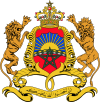Barghawata Confederacy | |||||||||
|---|---|---|---|---|---|---|---|---|---|
| 744–1058 | |||||||||
 Barghawata Confederacy (blue) | |||||||||
| Common languages | Berber (Lisan al-Gharbi) | ||||||||
| Religion | Official : Islam-influenced Traditional Berber religion (adopted by 12 tribes) Other : Islam (Khariji)(adopted by 17 tribes) | ||||||||
| Government | Monarchy Tribal confederacy (29 tribes) | ||||||||
| King | |||||||||
• 744 | Tarif al-Matghari | ||||||||
• 961 | Abu Mansur Isa | ||||||||
| Historical era | Middle Ages | ||||||||
• Established | 744 | ||||||||
• Disestablished | 1058 | ||||||||
| |||||||||
| History of Morocco |
|---|
 |
The Barghawatas (also Barghwata or Berghouata) were a Berber tribal confederation on the Atlantic coast of Morocco, belonging to the Masmuda confederacy.[1] After allying with the Sufri Kharijite rebellion in Morocco against the Umayyad Caliphate, they established an independent state (AD 744-1058) in the area of Tamesna on the Atlantic coast between Safi and Salé under the leadership of Tarif al-Matghari.
- ^ Le Tourneau, R. (1986) [1960]. "Barg̲h̲awāṭa". In Bearman, P.; Bianquis, Th.; Bosworth, C.E.; van Donzel, E.; Heinrichs, W.P. (eds.). Encyclopaedia of Islam. Vol. I (2nd ed.). Leiden, Netherlands: Brill Publishers. p. 1043. doi:10.1163/1573-3912_islam_SIM_1231. ISBN 9004081143.